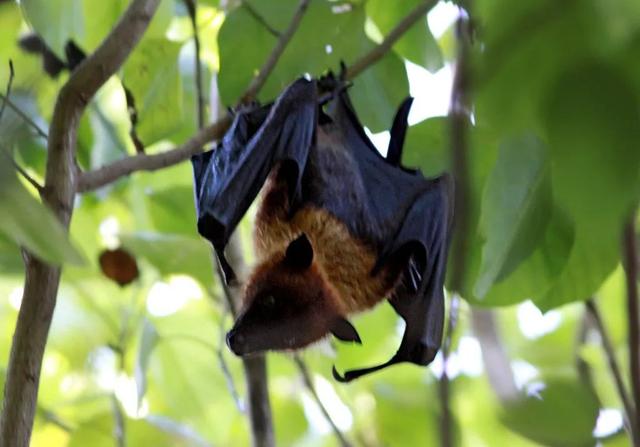全球濒危动物列表(你不知道的世界濒危动物)
全球濒危动物列表(你不知道的世界濒危动物)04中澳粗尾鼠双色獠狨一般指黑白柽柳猴(学名:Saguinus bicolor)是一种濒危的灵长类动物,色泽主要是黑、白、褐三色,尾长,仅大脚趾具扁甲,其余各指、趾均为爪状的尖爪;胸部有1对乳头;后肢比前肢长;牙齿32枚。栖于热带雨林或热带森林草原的树冠上层,很少到地面活动。吃水果、坚果和其他植物性食物,亦食昆虫、蜘蛛、青蛙、小蜥蜴和鸟蛋。视觉敏锐,听、嗅觉次之。白天活动,以家族形式3~12只结群生活。双亲共同哺育幼仔。分布在巴西亚马逊雨林。02金竹驯狐猴金竹驯狐猴(学名:Hapalemur aureus)是一种小型狐猴,头尾全长52-85厘米,头体长28-45 厘米,体重1-1.5 千克,只有小猫大小。背部皮毛浅橙色,有灰色至褐色针毛,下体黄色。脸颊黑色,有很短的口吻,眉毛、脸颊和喉部金黄色,毛茸茸的短耳朵。通常雄性和雌性有相似的外观,但雌性上体往往稍微更灰。主要栖息在马达加斯加潮湿的热

上一期小编带大家介绍了10种世界濒危动物,今天接着给大家介绍几种世界濒危动物,如果你感兴趣的话就看下去吧!
01白胸狐蝠
白胸狐蝠,又名鲁克狐蝠,鹿岛狐蝠,是狐蝠科狐蝠属下的一种,主要分布于密克罗尼西亚联邦。在1996年时在IUCN红色名录内列为极危物种,至1989年后当地禁止了对其捕猎,数目渐趋稳定。

02金竹驯狐猴
金竹驯狐猴(学名:Hapalemur aureus)是一种小型狐猴,头尾全长52-85厘米,头体长28-45 厘米,体重1-1.5 千克,只有小猫大小。背部皮毛浅橙色,有灰色至褐色针毛,下体黄色。脸颊黑色,有很短的口吻,眉毛、脸颊和喉部金黄色,毛茸茸的短耳朵。通常雄性和雌性有相似的外观,但雌性上体往往稍微更灰。主要栖息在马达加斯加潮湿的热带雨林中和竹林中。

03双色獠狨
双色獠狨一般指黑白柽柳猴(学名:Saguinus bicolor)是一种濒危的灵长类动物,色泽主要是黑、白、褐三色,尾长,仅大脚趾具扁甲,其余各指、趾均为爪状的尖爪;胸部有1对乳头;后肢比前肢长;牙齿32枚。栖于热带雨林或热带森林草原的树冠上层,很少到地面活动。吃水果、坚果和其他植物性食物,亦食昆虫、蜘蛛、青蛙、小蜥蜴和鸟蛋。视觉敏锐,听、嗅觉次之。白天活动,以家族形式3~12只结群生活。双亲共同哺育幼仔。分布在巴西亚马逊雨林。

04中澳粗尾鼠
中澳粗尾鼠,又名中澳白尾鼠,是一种鼠。它们只分布在澳洲。他们的地面活动主要是觅食。取食范围不大,多在距洞口1-5米左右,很少到10米以外取食。行动迅速,每次采食时间仅10-20秒,将植物杆茎咬断,很快拖回洞内,或置于洞口附近,然后立即再次采食。连续采食10-20次后,才在洞内停留一个时间。冬季不冬眠,栖息地覆雪后,则在雪被之下凿掘纵横交错的“雪道",并在其间活动,一般不到雪面上来。

05太平洋鼠海豚
太平洋鼠海豚体长1.85米,体重一般在50至60千克之间,是一种较小的齿鲸。以鱼为食。主要海岸附近、约20米中等深度并且比较平静的海域。由于人类捕杀和环境污染,太平洋鼠海豚濒临灭绝。他们濒危的原因主要就是人类的捕鲸活动以及环境污染,21世纪以来对鼠海豚最大的威胁来自于海洋的环境污染,尤其重金属如汞、铅或镉会在鲸的肌肉和肝脏里堆积起来。能够溶于油中的环境毒质如多氯联苯和滴滴涕会聚集在脂肪中。焦油和油层会导致皮肤坏死,与其它毒质一起它们进一步削弱鼠海豚,其结果是生病和严重受寄生虫侵袭的动物数量增加。

06达尔文狐
达尔文狐头体长53厘米,尾长22厘米,脚长10厘米,耳长26厘米,体重2.8千克。是一种体形非常小的狐狸,大小和一只家猫差不多。这种狐狸的耳朵短而圆;腿比较短;细长的身体和短而浓密的尾巴为其特征。喜欢生活在次生森林,以适应温带雨林植物的典型区域。在奇洛埃岛,森林是巴尔迪维亚式的。它包含针叶树种,少数常绿树种和带状果树林。该岛的北部和东部地区居住着人类,农业也对这一地理景观产生了一些影响。在岛的西海岸,达尔文狐充分利用由沙丘而导致的支离破碎的常绿森林栖息地。大陆种群发现在茂密的南洋杉和五种山毛榉树组成的森林中。

07 麋鹿
麋鹿,又名“四不像”,是世界珍稀动物,属于鹿科。因为它头脸像马、角像鹿、蹄子像牛、尾像驴,因此得名四不像。原产于中国长江中下游沼泽地带,以青草和水草为食物。性好合群,善游泳,喜欢以嫩草和水生植物为食。求偶发情始于6月底,持续6周左右。曾经广布于东亚地区。后来由于自然气候变化和人为因素,在汉朝末年就近乎绝种。元朝时,为了供游猎,残余的麋鹿被捕捉运到皇家猎苑内饲养。到19世纪时,只剩在北京南海子皇家猎苑内一群。在西方发现后不久被八国联军捕捉并从此在中国消失。直到1898年被英国购买并繁殖到255头,并在1983年将部分个体送回中国。之后有更多的麋鹿回归家乡,并有部分被放生野外。

08弓角羚羊
弓角羚羊,别称中华对角羚,几乎一生都不喝水,水份都自摄食植物中获取。主要栖于半沙漠地区,由于沙漠植物不足,故常旅行千里觅食;尽管栖息地的环境非常困厄,但身体仍十分健康。多以5~20只为群移动,由年长的公羚领队。沙漠中的羚羊,蹄呈扇形,很适合沙地行走,不致陷入沙中。中华对角羚是中国独有的、仅存在于环青海湖地区的极度濒危野生动物。因雄羚长着环棱相向对弯的黑色硬角而得名。对角羚(普氏原羚)是世界上最濒危的羚羊。

译文:
The last issue of the editor introduced you to 10 endangered animals in the world and today I will introduce you to several endangered animals in the world. If you are interested just read it!
1. White-breasted flying fox
The white-breasted flying fox also known as the Luke flying fox Kashima flying fox is a species of the flying fox family mainly distributed in the Federated States of Micronesia. It was listed as a critically endangered species in the IUCN Red List in 1996 and hunting for it was banned after 1989 and the number gradually stabilized.
2. Golden Bamboo Taming Lemur
The golden bamboo tamer lemur (scientific name: Hapalemur aureus) is a small lemur with a head and tail length of 52-85 cm a head and body length of 28-45 cm and a weight of 1-1.5 kg only the size of a kitten.
The fur on the back is light orange with gray to brown needle hair and the lower body is yellow. The cheeks are black with a short muzzle the eyebrows cheeks and throat are golden yellow and the hairy short ears. Males and females usually have similar appearance but female upper body tends to be slightly grayer. Mainly inhabits in Madagascar's humid tropical rainforest and bamboo forest.
3. Two-color tamarin
The bicolor tamarin generally refers to the black and white tamarin (scientific name: Saguinus bicolor) is an endangered primate. The color is mainly black white and brown. The tail is long only the big toe has flat nails and the rest of the fingers and toes. All are claw-like pointed claws; there are a pair of nipples on the chest; hind limbs are longer than forelimbs; 32 teeth.
It lives in the upper layer of the canopy of tropical rainforests or tropical forests and grasslands and rarely moves on the ground. Eat fruits nuts and other plant foods as well as insects spiders frogs small lizards and bird eggs. He has sharp vision followed by hearing and smell. Active during the day living in groups of 3 to 12 in the form of a family.
Both parents nurture their cubs together. Distributed in the Amazon rainforest in Brazil.
4. China-Australia Couch
The Chinese-Australian rat also known as the Chinese-Australian white-tailed rat is a kind of rat. They are only distributed in Australia. Their ground activities are mainly foraging. The feeding range is not large mostly about 1-5 meters from the entrance of the cave and rarely 10 meters away. The action is fast and each feeding time is only 10-20 seconds.
The plant stems are snapped off quickly dragged back into the hole or placed near the hole and then eat again immediately. After 10-20 consecutive feedings he stayed in the cave for a while.
There is no hibernation in winter. After the habitat is covered with snow the criss-crossing "snow trails" are dug under the snow cover and activities are carried out in the meantime generally not coming from the snow.
5. Pacific porpoise
The Pacific porpoise is 1.85 meters long and generally weighs between 50 and 60 kilograms. It is a smaller toothed whale. Feed on fish. Near the main coast about 20 meters of medium depth and relatively calm sea. Due to human hunting and environmental pollution the Pacific porpoise is on the verge of extinction.
The main reasons for their endangerment are human whaling activities and environmental pollution.
Since the 21st century the biggest threat to porpoises comes from marine environmental pollution. In particular heavy metals such as mercury lead or cadmium will accumulate in the muscles and liver of whales. Environmental toxicants such as PCBs and DDT that are soluble in oil will accumulate in fat.
Tar and oil layers can cause skin necrosis. Together with other poisons they further weaken the porpoise. The result is an increase in the number of sick and heavily parasite-infested animals.
6. Darwin Fox
Darwin's fox has a head length of 53 cm a tail length of 22 cm a foot length of 10 cm an ear length of 26 cm and a weight of 2.8 kg. It is a very small fox about the size of a domestic cat. The ears of this fox are short and round; the legs are relatively short; it is characterized by a slender body and a short bushy tail.
Like to live in secondary forests to adapt to typical areas of temperate rain forest plants. On Chiloe Island the forest is Baldivian style. It contains coniferous species a few evergreen species and banded fruit forests. The northern and eastern parts of the island are inhabited by humans and agriculture has also had some influence on this geographical landscape.
On the west coast of the island the Darwin Fox takes full advantage of the fragmented evergreen forest habitat caused by sand dunes. The continental population is found in dense forests of araucaria and five types of beech trees.
7. Elk
Elk also known as "Four Unsimilars" is a rare animal in the world and belongs to the deer family.
Because its face resembles a horse its horns resemble a deer its hooves resemble an ox and its tail resembles a donkey it gets its name from four different. It is native to swamps in the middle and lower reaches of the Yangtze River in China. It feeds on grass and aquatic plants. Good sex good swimming like to feed on tender grass and aquatic plants.
Courtship heat begins at the end of June and lasts about 6 weeks. It was once widely distributed in East Asia. Later due to natural climate changes and human factors it was almost extinct at the end of the Han Dynasty. In the Yuan Dynasty the remaining elk were captured and transported to the Royal Hunting Garden for safari hunting. By the 19th century only one group remained in the Royal Hunting Garden in Nanhaizi Beijing.
It was captured by the Eight-Power Allied Forces shortly after being discovered in the West and has since disappeared in China. It was bought by the British in 1898 and bred to 255 and some individuals were sent back to China in 1983. Later more elk returned to their hometowns and some were released into the wild.
8. Bowhorn Antelope
The bow-horned antelope also known as the Chinese diagonal antelope does not drink water for almost all of its life. The water is obtained from feeding plants. Mainly inhabiting semi-desert areas. Due to the shortage of desert plants they often travel thousands of miles to forage; although the habitat environment is very difficult they are still very healthy.
Most of them move in groups of 5-20 led by the older male antelope. The antelope in the desert has fan-shaped hoofs which is very suitable for walking on the sand and will not sink into the sand.
The Chinese antelope is a critically endangered wild animal unique to China and only exists in the area around Qinghai Lake. It is named after the male antelope has black hard horns with opposite edges. Diagonal antelope (Przewalski's gazelle) is the most endangered antelope in the world.
——来源:Google翻译
参考资料:百度百科
本文由LearningYard学苑原创,部分图片、音乐来源于网络,如侵权请沟通。




